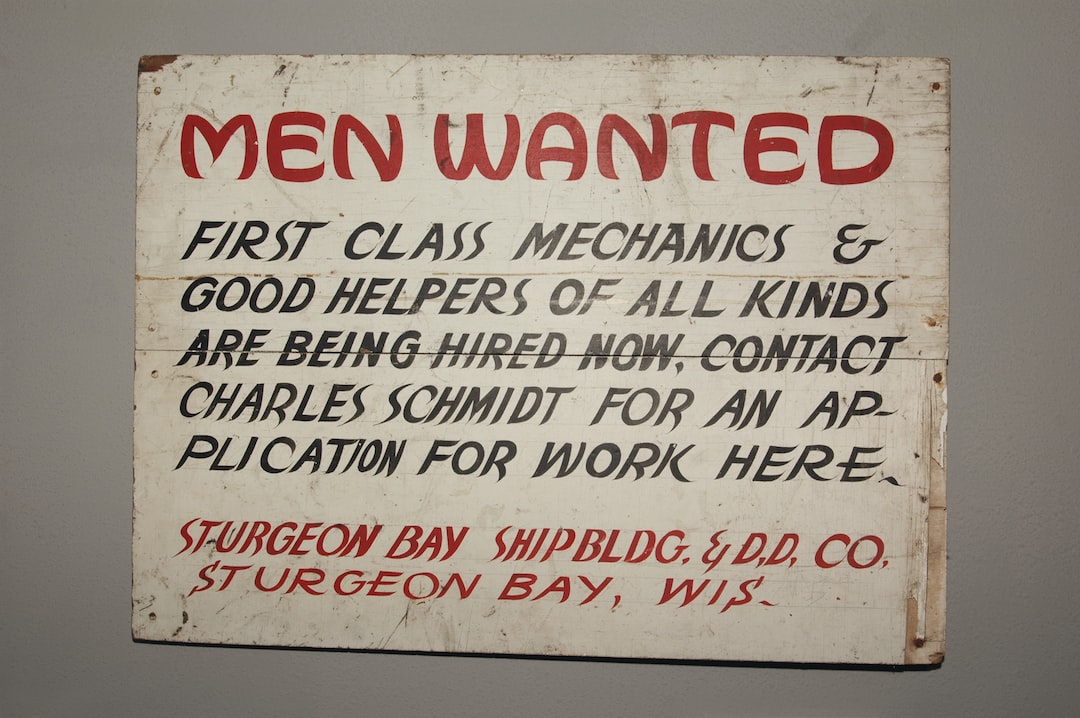The True Cost Of An Employee: How Much Do They Really Cost Your Business?
The True Cost Of An Employee: How Much Do They Really Cost Your Business?
1. Introduction
The cost of an employee is not simply their salary. When you factor in the cost of benefits, training, and other factors, the true cost of an employee can be much higher. As a business owner, it is important to understand the true cost of your employees so that you can make informed decisions about your workforce.
In this article, we will explore the true cost of an employee and how different factors can impact the cost of your workforce. We will also provide some tips on how you can reduce the cost of your employees.
https://unsplash.com/@agefis
2. The True Cost of an Employee
When calculating the true cost of an employee, there are many factors to consider. In addition to salary, there are the costs of benefits, bonuses, overtime, and paid time off. These all add up to the total cost of the employee.
Benefits are a major expense for employers. On average, the cost of benefits per employee is around 27% of their total salary. This can include health, dental, and vision insurance, 401(k) plans, paid vacation, sick days, and other perks.
Another important cost to consider is training. Not only does training cost money, but it also takes up time. To ensure that your employees are well-trained and able to perform their job correctly, you may need to invest in both external and internal training.
Finally, it is important to factor in potential turnover costs when considering the true cost of an employee. This includes any expenses you might incur during the hiring process as well as the cost of lost productivity when a position is vacant.
The true cost of an employee can be high, but understanding the various costs and taking steps to reduce them can save your business money in the long run.
https://unsplash.com/@shridhar
3. The Breakdown of the Cost of an Employee
One of the best ways to understand the true cost of a current or potential employee is to break down the cost in details. The cost of the employee includes the base salary, employer contributions, benefits, training, overhead, and potential turnover costs.
1. Base Salary - This includes any base pay you are offering to your employee and is the largest cost associated with an employee.
2. Employer Contributions - This is any amount of money the employer contributes to the employee’s pay such as health insurance, 401(k) plans, and pension plans.
3. Benefits - These are the additional perks the employee receives, such as paid vacation time, health and medical insurance, tuition reimbursement, and other forms of compensation.
4. Training - This is the cost of training and developing the employee so they can keep up with industry changes. It includes internal training, external courses, and any other employee development resources.
5. Overhead - This includes non-salary costs related to having the employee on staff such as office space, furniture, and equipment.
6. Turnover Costs - These include the costs associated with hiring and onboarding a new employee when the current one leaves. These costs can be significant and include recruitment fees, advertising, interviewing time, and any other related costs.
https://unsplash.com/@towfiqu999999
4. The Benefits of Hiring an Employee
Hiring an employee is an important decision and should not be taken lightly. There are many costs associated with adding another employee to your team, but there can also be some great benefits.
1. Increased productivity - Having an extra set of hands and a new mind can help to boost productivity in the workplace. An additional employee can help to get tasks completed faster and more efficiently.
2. New skills - Hiring a new employee can bring a different set of skills and expertise to the table. This can help to jump start projects and open up possibilities that were not previously available.
3. Diversified perspectives - By bringing a different person to your team, you will gain another perspective on projects and tasks. This can help to bring a different angle and diversify your ideas.
4. Trust and Long-Term Commitment - Investing in a new employee indicates commitment to the organization’s goals and objectives. It also signals to the new employee that they can trust the organization.
An additional employee can be a great asset to an organization. While there are costs associated with this decision, if done correctly, it can bring immense benefit to the team and the business.
https://unsplash.com/@theyshane
5. The Risks of Not Hiring an Employee
On the flip side of the coin, there are also risks associated with not hiring a new employee when needed. If you do not hire an employee to fulfill a necessary role, you may end up with a team that is overloaded and overworked. This can lead to a decrease in productivity and quality of work.
Other risks might include:
1. Reliance on freelancers or contractors- If you do not hire an employee, you may end up relying too heavily on one or two freelancers/contractors. This can cause problems if they become unavailable for an extended period of time.
2. Limitations in Internal Growth- When you do not hire an employee, you may be missing out on potential internal growth opportunities. Not investing in employees could limit opportunities for them to move up in the company.
3. Higher Turnover- Without additional employees, current employees may become overworked and burnout at higher rates. This could lead to higher employee turnover rates.
4. Lack of Long-term Commitment- By not hiring an employee, you are missing out on the long-term commitment they can bring to your organization.
Though there may be some initial financial costs associated with hiring an employee, in the long run, it can bring important benefits to an organization. Investing in a new hire should not be taken lightly as the risks of not doing so can outweigh the costs.
https://unsplash.com/@anniespratt
6. To sum it all up
To sum it all up, hiring an employee can be an expensive, but necessary, investment. You must understand the true cost of an employee in order to make an informed decision about whether or not hiring is the right move for your business.
The true cost of hiring an employee goes beyond the calculated salary and benefits they receive. It includes the costs associated with recruitment, onboarding, equipment/supplies, monitoring, training, and development. There are also potential risks associated with not hiring an employee when they are needed. These risks include things like relying too heavily on freelancers/contractors, limitations in internal growth opportunities, higher employee turnover, and a lack of long-term commitment to the company.
Although there are associated costs and risks, in the end, it could be worth it. The true cost of an employee may be expensive, but businesses should evaluate the pros and cons of hiring in order to decide if it is the right move for them.
The True Cost Of An Employee: How Much Do They Really Cost Your Business?
1. Introduction
Most business owners are aware that they need to invest in their employees in order to get the most out of them. However, many don’t know how much they should be investing or what the true cost of an employee is to their business.
Investing in your employees is important, but you need to be strategic about it. You need to know how much to invest and where to invest in order to get the most return on your investment.
In this article, we will discuss the true cost of an employee and how much you should be investing in your employees to get the most out of them.
https://unsplash.com/@jentheodore
2. The True Cost of an Employee
When it comes to figuring out the true cost of an employee, there are several things that must be taken into account. These include:
1. Recruiting costs – These are the costs that are associated with finding, interviewing, and onboarding a new employee. This includes the cost of ads or job postings, recruiter or agency fees, and any associated travel or relocation costs.
2. Training costs – These are the costs associated with training your new employees. This can include the cost of training materials, the cost of having trainers come in to provide training, or the cost of sending employees to training courses outside your business.
3. Salary and benefits – This is the most obvious cost associated with hiring and training a new employee. This includes the salary you are paying as well as any associated benefits such as health insurance or retirement benefits.
4. Inconsistency costs – This is the cost associated with having to redo tasks that may not have been done correctly or that may have been done inefficiently due to lack of training.
5. Time costs – This is the cost associated with the time of managers who are overseeing the training of new employees and making sure that they are being productive and efficient.
All of these costs must be taken into consideration when calculating the true cost of an employee to your business. By getting a thorough understanding of these costs, you can make informed decisions about how best to invest in your employees and
https://unsplash.com/@austindistel
3. The Breakdown of the Cost of an Employee
The breakdown of the true cost of an employee to your business is as follows:
1. Recruiting Costs–Approximately 20-30% of the total cost of hiring an employee will come from the recruiting costs. This includes the cost of ads or job postings, recruiter or agency fees, and any associated travel or relocation costs.
2. Training Costs–Training costs typically make up about 30-40% of the total cost of an employee. This includes the cost of training materials, the cost of having trainers come in to provide training, or the cost of sending employees to training courses outside your business.
3. Salary & Benefits–Salary and benefits are typcially the largest cost to consider when calculating the true cost of an employee. Salary typically makes up around 35-45% of the costs. Benefits such as health insurance and retirement benefits make up the remaining 5-10%.
4. Inconsistency Costs–This cost usually accounts for 5-10% of the total cost of an employee. This includes the cost of errors due to lack of training or inefficiencies in the employee's work.
5. Time Costs–This cost will usually account for 5-10% of the total cost of an employee. This includes the cost of managers' time spent overseeing the training of the employee and ensuring their productivity.
By understanding these costs, you can better plan for the true cost of an employee to your business
https://unsplash.com/@austindistel
4. The Benefits of Hiring an Employee
Having the right employees for the right roles can bring numerous benefits to any business. These benefits include:
1. Increased Productivity – Hiring the right person means they have the correct skillset and attitude to get the job done quickly and efficiently. This, in turn, leads to increased productivity.
2. Improved Customer Service – Having an experienced and knowledgeable employee can help improve your customer's experience, increasing customer satisfaction and trust in your business.
3. Reduced Cost of Doing Business – When hiring an employee, you'll be able to tap into their skill set and knowledge, potentially reducing the overall cost of operating your business.
4. Increased Efficiency – Having the right employee for the job means there is less time spent in briefing, and more time spent doing. This means tasks are completed quicker, leading to increased efficiency.
5. Increased Profits – When you have the right employees in the right roles, your business can operate more efficiently, leading to more profits.
Hiring the right employee can bring these and many other benefits to any business. That's why it's essential to take the time to hire the right person for the role.
https://unsplash.com/@magnetme
5. The Risks of Not Hiring an Employee
As beneficial as having the right employee can be for any business, there are also risks associated with not hiring an employee. These risks include:
1.Lack of Productivity – Without an employee to perform certain tasks, work may slow down and can adversely affect productivity.
2. Poor Customer Service – Without an employee to provide customer service, customers may become dissatisfied or frustrated.
3.Rising Operating Costs – Without an employee to complete certain tasks, businesses may need to increase their spending to outsource services, which could lead to rising operating costs.
4.Inefficient Work Processes – Without an employee to help guide work processes, tasks may take longer to complete, leading to inefficiencies.
5. Loss of Profits – If tasks take too long to complete or customer service is poor, businesses can experience a decline in profits.
Overall, not having the right employee for the right job can be very costly for any business. It is essential to take the time to hire the right candidate for the job to avoid these risks.
https://unsplash.com/@geraldine_lewa
For any question, please contact us in OpenTimeClock.com. https://www.opentimeclock.com.
Created with the Personal Edition of HelpNDoc: Experience the Power and Simplicity of HelpNDoc's User Interface









